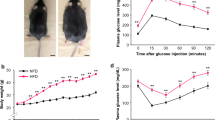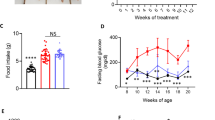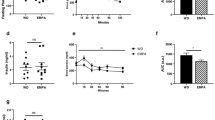Abstract
Cardiovascular risk is closely associated with insulin resistance and type 2 diabetes. Therapy based on the actions of GLP-1 is currently seen as a novel approach to treat this disease. The aims of this study was therefore to use an animal model to determine whether (i) pre-treatment of obese, insulin resistant but pre-diabetic rats with a DPP4 inhibitor, PFK275-055, could protect the heart from ischaemia/reperfusion injury and (ii) the possible mechanisms involved in such protection. Obese, pre-diabetic rats (DIO) were treated for 4 weeks with 10 mg/kg/day of the DPP4 inhibitor PFK275-055. Ex vivo perfusion was used to subject hearts to ischaemia/reperfusion to determine infarct size, functional recovery and post-ischaemic activation of proteins associated with cardiac protection. Adult ventricular cardiomyocytes were isolated to determine insulin sensitivity. Other assessments included body weight, intra-peritoneal fat weight, insulin and GLP-1 levels as well as histological evaluation of the pancreata. Results showed that DIO animals had higher body mass and intra-peritoneal fat mass than chow-fed animals. They presented with elevated plasma insulin levels and lower GLP-1 levels. Treatment with the DPP4 inhibitor resulted in smaller infarct size development in hearts from DIO rats after ischaemia/reperfusion accompanied by activation of cardioprotective kinases. GLP-1 levels were elevated and plasma insulin levels lower after treatment. In addition, the beta-cell to alpha-cell ratio of the pancreas was improved. We conclude that treatment with PFK275-055 for 4 weeks protected the heart against ischaemia/reperfusion injury, elevated GLP-1 levels and improved metabolic control in obese, pre-diabetic rats.





Similar content being viewed by others
References
Alexander CM, Landsman PB, Teusch SM, Haffner SM. NCEP-defined metabolic syndrome, diabetes and prevalence of coronary hart disease among NHANES III participants age 50 years and older. Diabetes. 2003;52:1210–3.
Hu G, Qiao Q, Tuomilehto J, Balkau B, Borch-Johnsen D, Pyorala K, et al. Prevalence of the metabolic syndrome and its relation to all-cause and cardiovascular mortality in nondiabetic European men and women. Arch Intern Med. 2004;164:1066–76.
Rader DJ. Effect of insulin resistance, dyslipidemia, and intra-abdominal adiposity on the development of cardiovascular disease and diabetes mellitus. Am J Med. 2007;120:S12–8.
Nauck M, Stöckmann F, Ebert R, Creutzfeldt W. Reduced incretin effect in type 2 (non-insulin-dependent) diabetes. Diabetologia. 1986;29:46–52.
Pratley RE. Overview of glucagon-like peptide-1 analogs and dipeptidyl peptidase-4 inhibitors for type 2 diabetes. Medscape J Med. 2008;10:171.
Tahrani AA, Piya MK, Kennedy A, Barnett AH. Glycaemic control in type 2 diabetes: targets and new therapies. Pharmacol Ther. 2009.
Nikolaidis LA, Mankad S, Sokos GG, Miske G, Shah A, Elahi D, et al. Effects of glucagon-like peptide-s in patients with acute myocardial infarction and left ventricular dysfunction after successful reperfusion. Circulation. 2004;109:962–5.
Mannucci E, Rotella CM. Future perspectives on glucagon-like peptide-1, diabetes and cardiovascular risk. Nutr Metab Cardiovasc Dis. 2008;18:639–45.
Zhao T, Parikh P, Bhashyam S, Bolukoglu H, Poornima I, Shen Y-T, et al. The direct effects of Glucagon-like peptide-1 (GLP-1) on myocardial contractility and glucose uptake in normal and post-ischemic isolated rat hearts. J Pharmacol Exp Ther. 2006;317:1106–13.
Bose AK, Mocanu MM, Carr RD, Brand CL, Yellon DM. Glucagon-like peptide 1 can directly protect the heart against ischemia/reperfusion injury. Diabetes. 2005;54:146–50.
Huisamen B, Genade S, Webster I, Lochner A. Signalling pathways activated by glucagon-like peptide-1 (7-36) amide in the heart and their role in protection against ischemia. Cardiovasc J Afr. 2008;19:77–83.
Montrose-Rafizadeh C, Egan JM, Roth J. Incretin hormones regulate glucose-dependent insulin secretion in RIN 1046-38 cells: mechanism of action. Enocrinology. 1994;135:589–94.
Egan JM, Montrose-Rafizadeh C, Wang Y, Bernier M, Roth J. Glucagon-like peptide-1 (7-36) amide (GLP-1) enhances insulin-stimulated glucose metabolism in 3T3-L1 adipocytes: one of several potential extrapancreatic sites of GLP-1 action. Endocrinology. 1994;135:2070–5.
Valverde I, Morales M, Clementi F, Lopez-Delgado MI, Delgado E, Perea A, et al. Glucagon-like peptide-I: a potent glycogenic hormone. FEBS Lett. 1994;349:313–6.
Deacon CF. What do we know about the secretion and degradation of incretin hormones? Regul Pept. 2005;128:117–24.
Barnett A. DPP4 inhibitors and their potential role in the manegement of type 2 diabetes. Int J Clin Pract. 2006;60:1454–70.
Drucker DJ, Nauck MA. The incretin system: glucagon-like peptide-1 receptor agonists and dipeptidyl peptidase-4 inhibitors in type 2 diabetes. Lancet. 2006;368:1696–705.
Ahrén B, Foley JE. The islet inhancer cildagliptin: mechanisms of improved glucose metabolism. Int J Clin Pract Suppl. 2008;159:8–14.
Vilsbøll T. The effects of glucagon-like peptide-1 on the beta cell. Diab Obes Metab. 2009;11:11–8.
Mafong DD, Henry RR. The role of incretins in cardiovascular control. Curr Hypertens Rep. 2009;11:18–22.
Pickavance LC, Tadayyon M, Widdowson PS, Buckinham RE, Wilding JPH. Therapeutic index for rosiglitazone in dietary obese rats: separation of efficacy and haemodilution. Br J Pharmacol. 1999;128:1570–6.
Du Toit EF, Nabben M, Lochner A. A potential role for angiotensin II in obesity induced cardiac hypertrophy and ischaemic/reperfusion injury. Basic Res Cardiol. 2005;100:346–54.
Villhauer EB, Brinkman JA, Naderi GA, et al. 1-[[(3-Hydroxy-1-adamantyl)amino]acetyl]-2-cyano-(S)-pyrrolidine: a potent, selective, and orally bioavailable dipeptidyl peptidase IV inhibitor with antihyperglycemic properties. J Med Chem. 2005;46:2774–89.
Lochner A, Genade S, Moolman JA. Ischemic preconditioning: infarct size is a more reliable endpoint than functional recovery. Basic Res Cardiol. 2003;98:337–46.
Marais E, Genade S, Salie R, Huisamen B, Maritz S, Moolman JA, et al. The temporal relationship between p38 MAPK and HSP27 activation in ischaemic and pharmacological preconditioning. Basic Res Cardiol. 2005;100:35–47.
Donthi R, Huisamen B, Lochner A. The effect of vanadate and insulin on glucose transport in isolated adult rat cardiomyocytes. Cardiovasc Drugs Ther. 2000;14:463–70.
Lowry OH, Rosebrough NJ, Farr AL, Randall RJ. Protein measurement with the Folin phenol reagent. J Biol Chem. 1951;193:265–75.
Holst JJ, Deacon CF. Glucagon-like peptide-1 mediates the therapeutic actions of DPPIV inhibitors. Diabetologia. 2005;48:612–5.
Hausenloy DJ, Yellon DM. New directions for protecting the heart against ischaemia-reperfusion injury: targeting the reperfusion injury salvage kinase (RISK)-pathway. Cardiovasc Res. 2004;15:448–60.
Ban K, Noyan-Ashraf H, Hoefer J, Bolz S-B, Drucker DJ, Husain M. Cardioprotective and vasodilatory actions of glucagon-like peptide 1 receptor are mediated through both glucagon-like peptide 1 receptor dependent and independent pathways. Circulation. 2008;117:2340–50.
Naderali EK, Pickavance LC, Wilding JPH, Williams G. Diet-induced endothelial dysfunction in the rat is independent of the degree of increase in total body weight. Clin Sci. 2001;100:635–41.
Ahrén B. Inhibition of depeptidyl peptidase-4 (DPP-4)—a novel approach to treat type 2 diabetes. Curr Enzyme Inhib. 2005;1:65–73.
Augstein P, Berg S, Heinke P, et al. Diab Obes Metab. 2008;10:850–61.
Pospisilik JA, Martin J, Dory T, et al. Dipeptidyl peptidase IV inhibitor treatment stimulates beta-cell survival and islet neogenesis in streptozotocin-induced diabetic rats. Diabetes. 2003;52:741–50.
Author information
Authors and Affiliations
Corresponding author
Rights and permissions
About this article
Cite this article
Huisamen, B., Genis, A., Marais, E. et al. Pre-treatment with a DPP-4 Inhibitor is Infarct Sparing in Hearts from Obese, Pre-diabetic Rats. Cardiovasc Drugs Ther 25, 13–20 (2011). https://doi.org/10.1007/s10557-010-6271-7
Published:
Issue Date:
DOI: https://doi.org/10.1007/s10557-010-6271-7




